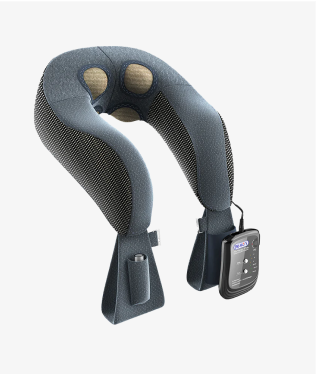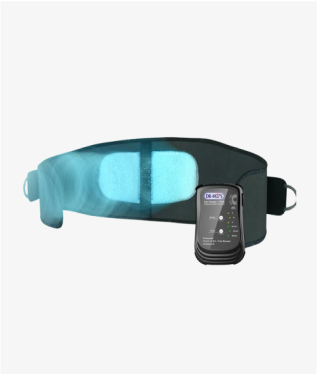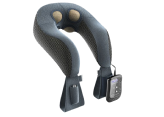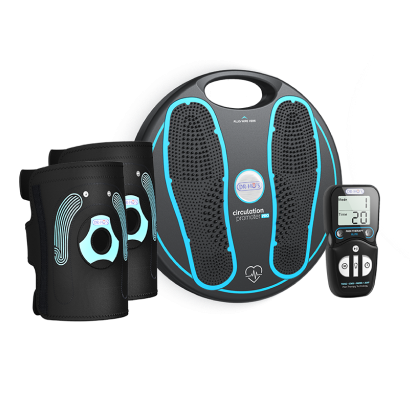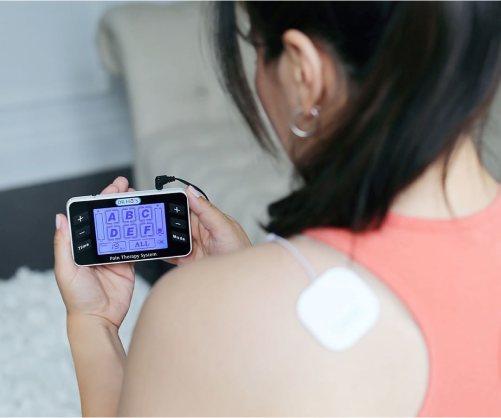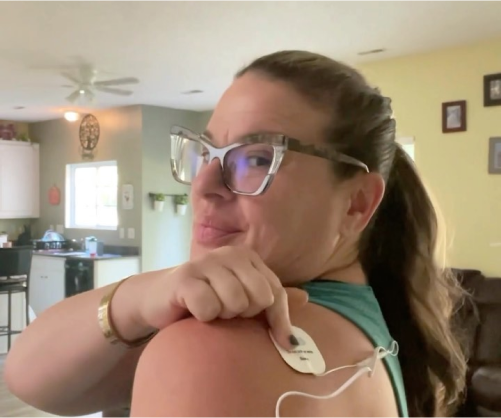Electrical Muscle Stimulation (EMS) is a technology that uses electrical impulses to activate muscles. EMS works by delivering electrical current through electrodes placed on the skin, causing muscle contraction similar to the signals sent by the central nervous system. This process can help strengthen muscles, improve endurance, and aid in rehabilitation.
EMS is also widely used by elite athletes as part of their physical training to enhance muscle strength, endurance, and overall athletic performance.
Dealing with muscle pain? You came to the right place.
Anyone who has lived with chronic pain and related conditions knows that pain and discomfort can strike unexpectedly, and when it does, it can be intrusive and even detrimental to your everyday life. Because of this, pain-sufferers are often seeking out new ways to find relief so they can get back to doing the things they love. And for any variety of reasons, you may be looking to accomplish this without the use of prescription medications or invasive procedures.
Traditional physical training routines often involve complex and demanding exercises, which can be difficult for many people experiencing pain. EMS can be an effective option for those who find traditional exercises challenging, offering a simpler and more accessible alternative for muscle activation and pain relief.
If you’re one of these pain-sufferers who’s looking for new ways to manage pain, a TENS device can be just what you’re looking for. Specifically, if you’re dealing with muscle-related pain, you may find that the EMS technology in TENS devices can target your pain effectively and meaningfully. EMS works by inducing involuntary muscle contractions, which can help relieve pain and improve muscle function. Research on EMS often involves healthy subjects to assess its benefits and effectiveness. Keep reading to learn the basics about TENS and EMS, and to see if this form of pain management is right for you.
What Is TENS?
TENS Therapy: TENS (Transcutaneous Electrical Nerve Stimulation) gently stimulates the nerves with electrical stimulation to help reduce pain signals sent to the brain and thus provide temporary relief of pain. A TENS unit is the device used to deliver this therapy. Additionally, TENS therapy is thought to aid in the release of endorphins — a naturally-occurring chemical that may also provide temporary pain relief.

What about EMS?
EMS Therapy: EMS (Electrical Muscle Stimulation), also known as neuromuscular electrical stimulation in medical and rehabilitation contexts, works in tandem with TENS in DR-HO’S devices to target the muscles in addition to the nerves, allowing more people dealing with all kinds of pain to find effective, temporary relief when it’s needed most.
EMS gently stimulates the muscles in pain-affected areas, causing them to contract and relax in order to increase local circulation and soothe achiness and soreness — whether your pain was caused by an acute injury or a chronic condition. The electrical impulses from EMS stimulate muscle fibers, leading to muscle contraction and adaptation. Stimulating healthy muscles also helps improve and facilitate muscle performance, and an increase in local circulation is thought to help deliver oxygen and other nutrients through the bloodstream, to the muscles. EMS can target all the muscles in the treated area, ensuring comprehensive muscle engagement. Adding EMS to an exercise or rehabilitation program can help improve muscle function.

When muscle pain strikes, it’s important to have a device on hand that you can rely on for fast-acting, temporary relief — especially considering how intrusive and unexpected a flare-up of pain can be. While EMS can’t address the underlying condition causing muscle pain, it can help pain-sufferers get back to some of their normal activities, and feel more like themselves again.

EMS Equipment and Safety
Electrical Muscle Stimulation (EMS) equipment is designed to help you get the most out of your muscles by delivering controlled electrical impulses that trigger muscle contractions. Whether you’re looking to improve muscle strength, enhance muscle function, or support your recovery after an injury, EMS training can be a powerful addition to your routine. These devices typically include a control unit, electrodes that are placed on the skin over major muscle groups, and adjustable settings to tailor the intensity and duration of each session.
Safety is a top priority when using any electrical stimulation device. To ensure you get the benefits of EMS while minimizing risks, always follow the manufacturer’s instructions closely. Start with a low intensity and gradually increase as your body adapts. It’s important to avoid placing electrodes on sensitive areas like the eyes, ears, or throat, and EMS should not be used by individuals with certain medical conditions, such as those with pacemakers or epilepsy, unless cleared by a healthcare professional.
Maintaining your EMS equipment is just as important as using it correctly. Clean and disinfect electrodes and pads after each use, store your device in a dry, safe place, and never use EMS equipment near water or in humid environments. These simple steps help ensure your training sessions are both effective and safe.
EMS training isn’t just for athletes or people seeking to boost their fitness. Research shows that electrical muscle stimulation can benefit a wide range of individuals, including those with chronic obstructive pulmonary disease (COPD) or chronic heart failure, by helping to improve muscle endurance and function. When combined with dynamic weight training or other forms of physical exercise, EMS can provide a comprehensive approach to improving body composition and overall health.
In the context of emergency medical services (EMS), safety extends beyond personal fitness. EMS clinicians rely on specialized equipment—such as defibrillators and oxygen therapy devices—to provide emergency medical care during critical incidents. A coordinated response and strict adherence to safety protocols are essential for protecting both patients and providers in prehospital services, hospitals, and other healthcare settings.
Ultimately, whether you’re using EMS for training, rehabilitation, or as part of a comprehensive EMS system in emergency medical care, prioritizing safety and proper use is key. By following guidelines, maintaining your equipment, and using EMS responsibly, you can maximize the benefits of electrical muscle stimulation—improving muscle strength, supporting recovery, and even saving lives in emergency situations.
What makes DR-HO'S devices different?
While there are other TENS and EMS devices on the market, DR-HO’S devices stand out from the crowd by incorporating a comprehensive 4-in-1 approach.
-
TENS (Transcutaneous Electrical Nerve Stimulation): This technology delivers precise electrical impulses that interact with nerve fibers, helping to temporarily interrupt pain signals before they reach the brain.
-
EMS (Electrical Muscle Stimulation): The EMS component of our system sends targeted signals that gently contract and release muscles in the treated area. This rhythmic activity helps promote local blood flow and can help temporarily reduce muscle tension.
-
NMES (Neuromuscular Electrical Stimulation): NMES technology reaches deeper muscle layers, encouraging more substantial muscle engagement. This helps support the treated area while promoting improved circulation.
-
Auto-Modulating Pulses: This system continuously varies the electrical impulses, ensuring your body doesn't become accustomed to a single pattern. This helps ensure sustained effectiveness throughout your treatment and prevents the diminishing returns often experienced with conventional devices.
Dr. Michael Ho’s proprietary technology provides over 300 different stimulations that vary in wavelength, frequency and rest periods. A recent systematic review has shown that EMS devices can be effective in improving muscle mass and strength, supporting their use in various settings. However, further research is needed to fully understand the benefits and to establish optimal protocols for EMS application.
These constantly-changing stimulations are programmed to automatically change, so you get a soothing variety of pulses as you’re using the device. DR-HO’S products can be used as part of a treatment plan for pain and rehabilitation, and are also utilized in health care settings for pain management and recovery. In addition to EMS devices, DR-HO'S offers other services to support comprehensive health and wellness. This proprietary technology is the key difference between DR-HO’S devices and other TENS devices on the market.

How can TENS & EMS devices be used?
DR-HO’S devices can be used in the following ways:
-
For temporary relief of pain associated with sore and aching muscles including leg pain and foot pain, back pain, arm pain, neck and shoulder pain due to exercise or normal household work activities.
-
For symptomatic relief and management of chronic, intractable pain and relief of pain associated with arthritis, including as part of treatment for conditions such as knee osteoarthritis.
-
To stimulate healthy muscles in order to improve and facilitate muscle performance, and to help maintain muscle strength and function over time. EMS can be used to train muscles, especially when traditional exercise is not possible, and can complement or substitute for traditional strength training.
-
To temporarily increase local blood circulation in healthy muscles. EMS can also serve as a form of physical activity for those unable to participate in conventional exercise.
Interested in TENS & EMS? Try a DR-HO'S device.
Take the first step towards finding temporary, symptomatic relief and management of chronic, intractable pain. You can try a TENS device risk-free with a 100-Day Money-Back Guarantee.
Learn more about these DR-HO’S TENS therapy products:
Disclaimer: DR-HO'S content is intended for informational purposes only and should not be taken as medical advice. Please consult a certified medical professional for diagnosis and treatment recommendations.




